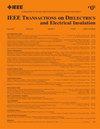Unraveling Plasma Characteristics and Breakdown Mechanism in Nanosecond-Pulsed Dielectric Barrier Discharge
IF 3.1
3区 工程技术
Q2 ENGINEERING, ELECTRICAL & ELECTRONIC
IEEE Transactions on Dielectrics and Electrical Insulation
Pub Date : 2025-04-15
DOI:10.1109/TDEI.2025.3561085
引用次数: 0
Abstract
Nanosecond-pulsed dielectric barrier discharges (DBDs) have gained significant attention for its promising applications in various fields. More systematic investigations are necessary to better understand the fundamental processes of pulsed DBD. In this study, the characteristics and the initial breakdown mechanism of atmospheric nanosecond-pulsed DBD are investigated. The electric field-induced second harmonic (E-FISH) technique is employed to investigate the electric field within the discharge gap. Additionally, the effects of pulse amplitude and pulse repetition rate on discharge characteristics, particularly the electric field, are analyzed. The results indicate that an increase in pulse amplitude leads to higher breakdown currents and a more pronounced reverse electric field peak, whereas the pulse repetition rate has a minimal effect on discharge behavior. A 2-D fluid model is developed to simulate discharge dynamics and analyze the spatiotemporal evolution of particles. Based on both experimental and simulation results, the discharge process is characterized by three distinct stages: Stage I (discharge breakdown), Stage II (surface charge accumulation), and Stage III (surface charge neutralization). The breakdown mechanism is further elucidated by examining the role of residual charges near the dielectric layer, which enhances the local electric field and facilitate the generation of secondary electrons, leading to ionization and subsequent discharge establishment.纳秒脉冲介质阻挡放电的等离子体特性和击穿机制
纳秒脉冲介质阻挡放电(DBDs)因其在各个领域的应用前景而受到广泛关注。为了更好地了解脉冲DBD的基本过程,有必要进行更系统的研究。本文研究了大气纳秒脉冲DBD的特性及其初始击穿机理。采用电场感应二次谐波(E-FISH)技术对放电间隙内的电场进行了研究。此外,还分析了脉冲幅值和脉冲重复率对放电特性的影响,特别是对电场的影响。结果表明,脉冲幅值的增加导致更高的击穿电流和更明显的反向电场峰值,而脉冲重复率对放电行为的影响最小。建立了二维流体模型来模拟放电动力学,分析颗粒的时空演化。基于实验和模拟结果,放电过程分为三个阶段:第一阶段(放电击穿)、第二阶段(表面电荷积累)和第三阶段(表面电荷中和)。通过考察介电层附近残余电荷的作用,进一步阐明了击穿机制,它增强了局部电场,促进了二次电子的产生,导致电离和随后的放电建立。
本文章由计算机程序翻译,如有差异,请以英文原文为准。
求助全文
约1分钟内获得全文
求助全文
来源期刊
CiteScore
6.00
自引率
22.60%
发文量
309
审稿时长
5.2 months
期刊介绍:
Topics that are concerned with dielectric phenomena and measurements, with development and characterization of gaseous, vacuum, liquid and solid electrical insulating materials and systems; and with utilization of these materials in circuits and systems under condition of use.

 求助内容:
求助内容: 应助结果提醒方式:
应助结果提醒方式:


